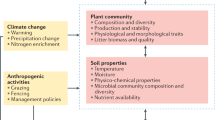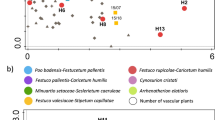Abstract
China launched the “Returning Grazing Lands to Grasslands” project about a decade ago to restore severely degraded grasslands. Grassland grazing exclusion was one of the experimental approaches for achieving the grand goal. Here, we evaluate the long-term regional ecological effects of grassland grazing exclusion in the Xilingol region of Inner Mongolia, China. The dynamics of grassland communities over 8 years (2004–2011) were continuously monitored at 11 research sites dominated by temperate steppe ecosystems. These sites represent the diverse landscapes of the Mongolian Plateau in the Arid, Semi-Arid, and Humid Climatic Zones that have varying precipitation levels. The community structure of degraded grasslands was found to recover quickly toward a benign state after grazing exclusion. The exclusion promoted an increase in mean plant community height, coverage, aboveground fresh biomass, and quality. The grasslands recovered fastest and most favorably in the Humid Zone followed by the Semi-Arid Zone and the Arid Zone. The increase in the aboveground biomass and vegetation height correlated significantly with the amount of total growing season precipitation. Precipitation therefore amplified the grazing exclusion effects on grassland restoration. Grazing exclusion was most effective in the relatively moist part of the study region. However, other factors such as global climate change and variability might have interacted with grazing management practices, thereby influencing the outcomes of grassland restoration efforts in Inner Mongolia. Future implementations of grassland ecosystem management should consider the regional climatic heterogeneity to maximize costs/benefits for achieving long-term ecosystem sustainability.









Similar content being viewed by others
References
Allen EB, Covington WW, Falk DA (1997) Developing the conceptual basis for restoration ecology. Restor Ecol 5:275–276
Batu NC, Hu YF, Yan Y, Liu JY (2012) The variations and its spatial pattern of grassland changes in Xilinguole from1975 to 2009. J Resour Sci 34(6):1017–1023
Bradshaw AD (1997) What do we mean by restoration. In: Urbanska KM, Webb NR, Edwards PJ (eds) Restoration ecology and sustainable development. Cambridge University Press, Cambridge, pp 8–16
Cao S, Sun G, Zhang Z, Chen L, Feng Q, Fu B, McNulty SG, Shankman D, Tang J, Wang Y, Wei X (2011) Greening China naturally. Ambio 40:828–831. doi:10.1007/s13280-011-0150-8
Cao L, Xu JH, Chen YN, Li WH, Yang Y, Hong YL, Li Z (2013) Understanding the dynamic coupling between vegetation cover and climatic factors in a semiarid region—a case study of Inner Mongolia, China. Ecohydrology 6(6):917–926. doi:10.1002/eco.1245
Cease AJ, Elser JJ, Ford CF, Hao S, Kang L, Harrison JF (2012) Heavy livestock grazing promotes locust outbreaks by lowering plant nitrogen content. Science 335(6067):467–469. doi:10.1126/science.1214433
Chen S (1979) Overview of forage grass resources of Xilingol grassland. Grassl China 1(01):13–20
Chen ZZ, Wang SP (2000) China typical grassland ecosystem. Science Press, Beijing
Chen J, Wan S, Qi J, Henerbry G, Sun G, Kappas M (eds) (2013) Dryland East Asia: land dynamics amid social and climate change. HEP & De Gruyter, Berlin, p 467
China Ministry of Agriculture (2012) The grassland monitoring report. Available from http://www.agri.gov.cn/V20/SC/jjps. Accessed Aug 2013
Christensen NL, Bartuska A, Brown JH, Carpenter S, Antonio CD, Francis R, Franklin JF, MacMahon JA, Noss RF, Parsons DJ, Peterson CH, Turner MG, Moodmansee RG (1996) The report of the ecological society of America Committee on the scientific basis for ecosystem management. Ecol Appl 6(3):665–691
Davidson A, Csillag F (2003) A comparison of three approaches for predicting C4 species cover of northern mixed grass prairie. Remote Sens Environ 86:70–82
Dobson AP, Bradshaw AD, Baker AJM (1997) Hopes for the future: restoration ecology and conservation biology. Science 277(25):515–522
Faul F, Erdfelder E, Lang A-G, Buchner A (2007) G*Power 3: a flexible statistical power analysis program for the social, behavioral, and biomedical sciences. Behav Res Methods 39(2):175–191
Faul F, Erdfelder E, Buchner A, Lang A-G (2009) Statistical power analyses using G*Power 3.1: tests for correlation and regression analyses. Behav Res Methods 41:1149–1160
Floyd ML, Fleischner TL, Hanna D, Whitefield P (2003) Effects of historic livestock grazing on vegetation at Chaco Culture National Historic Park, New Mexico. Conserv Biol 17(6):1703–1711
Golodets C, Kigel J, Sternberg M (2010) Recovery of plant species composition and ecosystem function after cessation of grazing in a Mediterranean grassland. Plant Soil 329(1–2):365–378
Hao L, Wang JA, Shi PJ (2003) Vulnerability assessment of regional snow disaster of animal husbandry—taking pasture of Inner Mongolia as an example. J Nat Disaster 12(2):51–57
Heather FA, Andrea JB, van der René W, Sarah JW (2012) Grazing exclusion and phosphorus addition as potential local management options for the restoration of alpine moss-sedge heath. Biol Conserv 153:17–24
Li YH, Mo WH, Yang C, Ye B (1994) Aerial biomass and carrying capacity of steppe vegetation in Inner Mongolia and their relations with climate. J Arid Land Resour Environ 8(4):43–50
Li A, Wu JG, Huang JH (2012) Distinguishing between human-induced and climate-driven vegetation changes: a critical application of RESTREND in inner Mongolia. Landsc Ecol 27:969–982
Li YJ, Song XL, Yu WC, Wang H, Zhang GL, Yang DL (2013) Advance in the influence of rest–grazing on the grassland ecosystem. Agro-Environ Dev 30(4):62–71
Liu ZL, Wang W, Hao DY, Liang CZ (2002) Probes on the degeneration and recovery succession mechanisms of Inner Mongolia steppe. J Arid Land Resour Environ 26(1):84–91
Liu ZK, Wang SP, Chen ZZ, Wang YF, Han JG (2006) Properties of soil nutrients and plant community after rest grazing in Inner Mongolia steppe, China. Acta Ecol Sin 26(6):2048–2055
Liu YY, Evans JP, McCabe MF, de Jeu RAM, van Dijk AIJM, Dolman AJ, Saizen I (2013) Changing climate and overgrazing are decimating Mongolian Steppes. PLoS One 8(2):e57599. doi:10.1371/journal.pone.0057599
Liu D, Chen Y, Cai W, Dong W, Xiao J, Chen J, Zhang H, Xia J, Yuan W (2014) The contribution of China’s grain for green program to carbon sequestration. Landsc Ecol. doi:10.1007/s10980-014-0081-4
Lu N, Wilske B, Ni J, John R, Chen J (2009) Climate change in Inner Mongolia from 1955 to 2005—trends at regional, biome and local scales. Environ Res Lett 4:045006 (6pp). doi:10.1088/1748-9326/4/4/045006
Mazen A, Magid M, Hemmasi M, Lewis MF (1985) In search of power: a statistical power analysis of contemporary research in strategic management. In: Academy of management proceedings. Academy of Management, San Diego, pp 30–34
Nicholson SE, Farrar T (1994) The influence of soil type on the relationships between NDVI, rainfall and soil moisture in semi-arid Botswana: part I. NDVI response to rainfall. Remote Sens Environ 50:107–120
Pickup G, Bastin GN, Chewings VH (1994) Remote-sensing based condition assessment for non equilibrium rangelands under large-scale commercial grazing. Ecol Appl 4:497–517
Qi J, Chen J, Wan S, Ai L (2012) Understanding the coupled natural and human systems in Dryland East Asia. Environ Res Lett 7:015202. doi:10.1088/1748-9326/7/1/015202
Qin W, Zhu QK, Zhang XX, Li WH, Fang B (2006) Review of vegetation covering and its measuring and calculating method. J Northwest Sci-Tech Univ Agric For (Nat Sci Ed) 34(9):163–170
Shan GL, Xu Z, Ning F, Ma YB, Li LH (2008) Influence of enclosure year on community structure and species diversity on a typical steppe. Acta Prataculturae Sin 17(6):1–8
Shao C, Chen J, Li L (2013) Grazing alters the biophysical regulation of carbon fluxes in a desert steppe. Environ Res Lett 8:025012. doi:10.1088/1748-9326/8/2/025012
Teague WR, Dowhower SL, Baker S, Haile N, DeLaune PB, Conover DM (2011) Grazing management impacts on vegetation, soil biota and soil chemical, physical and hydrological properties in tall grass prairie. Agr Ecosyst Environ 141(3–4):310–322
Tong C, Wu J, Yong S, Yang J, Yong W (2004) A landscape-scale assessment of steppe degradation in the Xilin River Basin, Inner Mongolia, China. J Arid Environ 59:133–149
Valone TJ, Meyer M, Brown JH, Chew RM (2002) Time scale of perennial grass recovery in desertified arid grasslands following livestock removal. Conserv Biol 16(4):995–1002
Vega E, Montaña C (2011) Effects of overgrazing and rainfall variability on the dynamics of semiarid banded vegetation patterns: a simulation study with cellular automata. J Arid Environ 75(1):70–77
Wang SP, Li YH, Wang YF, Chen ZZ (2001) Influence of different stocking rates on plant diversity of Artemisia frigid community in Inner Mongolia Steppe. Acta Bot Sin 43(1):89–96
Wessels KJ, Prince SD, Zambatis N, Macfadyen S, Frost PE, Van Zyl D (2006) Relationship between herbaceous biomass and 1-km2 advanced very high resolution radiometer (AVHRR) NDVI in Kruger National Park, South Africa. Int J Remote Sens 27(5):951–973
Xiong HQ, Duan JY, Zhang XS (2011) Effects of grazing exclusion on plant community characteristics in a degraded Mu Us Sand land, Inner Mongolia, northern China. Ecol Environ Sci 20(2):233–240
Yeh E (2010) Restoring the grasslands? Available from http://www.chinadialogue.net/article/show/single/en/3470-Restoring-the-grasslands. Accessed Jan 2010
Yeo JJ (2005) Effects of grazing exclusion on rangeland vegetation and soils, East Central Idaho. West N Am Nat 65(1):91–102
Zhang JY, Wang Y, Zhao X, Xie G, Zhang T (2005a) Grassland recovery by protection from grazing in a semi-arid sandy region of northern China. New Zeal J Agr Res 48(2):277–284
Zhang JY, Zhao HL, Zhang TH, Zhao XY, Drake S (2005b) Community succession along a chronosequence of vegetation restoration on sand dunes in Horqin Sandy Land. J Arid Environ 62(4):555–566
Zhang LY, Liu AJ, Xin Q, Liu DF, Gan W (2006) Trend and analysis of vegetation variation of typical rangeland in Inner Mongolia—a case study of typical rangeland of Xilinguole. J Arid Land Resour Environ 20(2):185–190
Zhang CX, Wang XM, Li JC, Hua T (2011) Roles of climate changes and human interventions in land degradation: a case study by net primary productivity analysis in China’s Shiyanghe Basin. Environ Earth Sci 64:2183–2193
Zhen L, Ochirbat B, Lv Y, Wei YJ, Liu XL, Chen JQ, Yao ZJ, Li F (2010) Comparing patterns of ecosystem service consumption and perceptions of range management between ethnic herders in Inner Mongolia and Mongolia. Environ Res Lett 5. doi:10.1088/1748-9326/5/1/015001
Zheng YR, Xie ZX, Robert C, Jiang LH, Shimizu H (2006) Did climate drive ecosystem change and induce desertification in Otindag sandy land, China over the past 40 years? J Arid Environ 64:523–541
Zhou G, Wang Y (2002) Response of grassland plant community along Northeast China transect to water gradient. J Veg Sci 13:361–368
Zhou HJ, Rompaey AV, Wang JA (2009) Detecting the impact of the “Grain for Green” program on the mean annual vegetation cover in the Shaanxi province, China using SPOT-VGT NDVI data. Land Use Policy 26:954–960
Zhou W, Gang CC, Zhou L, Chen YZ, Li JL, Ju WM, Odeh I (2014) Dynamic of grassland vegetation degradation and its quantitative assessment in the northwest China. Acta Oecol 55:86–96
Acknowledgments
We would like to thank the three reviewers and the editors for their valuable comments and suggestions. Lisa Delp Taylor provided English editing. This research was funded by the National Natural Science Foundation of China (71373130, 41105112), Jiangsu Key Laboratory of Agricultural Meteorology Fund (No. KYQ1201), the One Hundred Person Project of the Chinese Academy of Sciences (O927581001), and the International Center for Ecology, Meteorology, and Environment (IceMe). Partial support was also from the Southern Research Station, USDA Forest Service.
Author information
Authors and Affiliations
Corresponding author
Rights and permissions
About this article
Cite this article
Hao, L., Sun, G., Liu, Y. et al. Effects of precipitation on grassland ecosystem restoration under grazing exclusion in Inner Mongolia, China. Landscape Ecol 29, 1657–1673 (2014). https://doi.org/10.1007/s10980-014-0092-1
Received:
Accepted:
Published:
Issue Date:
DOI: https://doi.org/10.1007/s10980-014-0092-1




